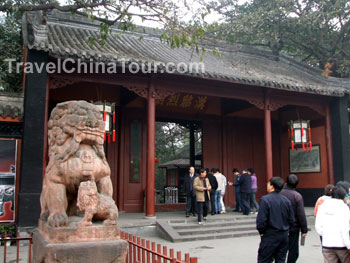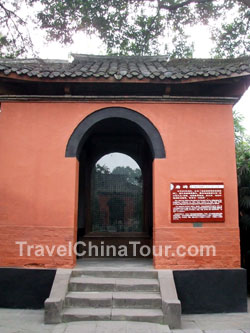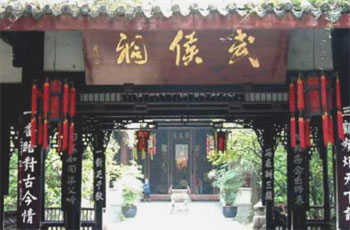When we walk into the temple and pick up a guide-map on the left side of the entrance. The map offers a picture of the temple and its illustration is in English. Generally speaking, the temple compound occupies a space of 37,000 square meters. The compound consists of five main buildings: the Front Gate, the Second Gate, Liu Bei’s Hall, Zhuge Liang’s Hall and Liu Bei’s Tomb. The compounds have a series of inner courtyards, the main buildings are built on a north-south axis(中轴线), the doors of the main buildings face south.
Making houses face south is a traditional practice in Chinese domestic architecture. Archeologists have found that many Neolithic-period houses were rectangular with a south-facing door. Settlements in the Zhou Dynasty were also organized on a north-south axis. These early dwellings no longer exist, but houses from the Ming Dynasty in China also show a tendency to face south. This practice is related to sunlight, and the direction of prevailing winds, especially cold winds.

Entrance of Wuhou temple.
The temple has 47 clay figures, 40 tablets, as well as 30 inscribed boards and couplets. It also stores over ten valuable ancient drums, stoves, bells and cooking vessels. Frankly speaking, the temple functions as a memorial hall in honor of Liu Bei and his subordinates.
Here are the six huge stone tablets. They flank the yard between the front and the second gates. Four of them were from the Qing Dynasty. The other two came either from the Ming or the Tang dynasties. The Qing tablets state the stories about the reestablishment of the temple; the Ming tablet illustrates its development.
Up and close to the Ming tablet, you’ll see a stone animal that is supporting the huge tablet on his back. What does the animal look like? Visitors always say the animal is a tortoise. As an old saying goes, the dragon has nine sons. Bixi is one of them. Each son has his own skill. Because of its great strength and endurance, Bixi always carries a tablet on his back.
The Tang tablet is better known than the other tablets. It is called the Three Perfection Tablet (三绝碑). Why do we highly praise the Tang tablet? The main reason is that several top scholars and well-known artists were involved in making the tablet.

The Tang tablet at Wuhou temple.
The essay began in 809 during the Tang Dynasty when Wu Yuanheng (武元衡), a local top military commander in Western Sichuan and his 27 assistants arrived at the temple to worship Zhuge Liang. Soon after the visit, the tablet was created to mark the special worship occasion.
The first scholar involved was Pei Du (裴度) who used to work as a prime minister for three Tang emperors indifferent times. He composed the tablet essay. In the essay, Pei Du eulogized Zhuge Liang for his great contribution to the process of unifying the whole China. He also commented on Zhuge Liang’s state-affairs management and military strategies, and encouraged the Tang officials to learn from Zhuge Liang. The second scholar was Liu Gongchuo (柳公绰) who was a well-known Tang calligraphy style.

Wuhou Temple
As you know, Chinese calligraphy is a kind of art, drawing characters with a Chinese brush. The Chinese word for calligraphy is "shufa" (书法), which means the writing method. There are several popular scripts. They include kaishu (楷书, the regular script), xingshu (行书, the running script) and caoshu (草书, the running script). The running scripts’ styled characters have a swift appearance and the strokes flow together in a cursive manner. These characters are so freely made that ordinary people have difficulty in reading them. You may ask me what kind of scripts the tablet has. I think it’s a regular script. Chinese artists call it the Liu-styled calligraphy.
The third person involved was an artist. He was Lu Jian (鲁建), a famous Tang stone mason. He engraved the essay on the tablet according to the pattern of Liu’s calligraphy. The three important figures joined hands to perfect the tablet. That is why people called it the Three Perfection Tablet.
Continue with the Wuhou Temple Tour
|